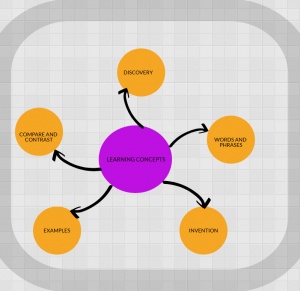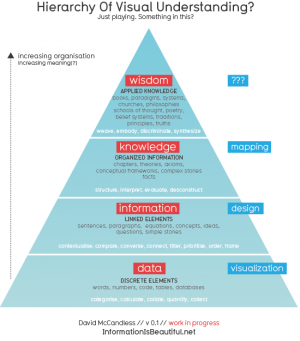Knowledge Management Essentials
Knowledge Management Essentials (hereinafter, the Session) is a hands-on session designed to get its participants started managing the knowledge relevant to WorldOpp. The Session is the ninth of ten sessions of CNMCyber Bootcamps (hereinafter, the Seminar).
Implementing concepts, conducting experiments, managing the knowledge
Contents
Outline
Composing the Documents is the predecessor session.
How to implement concepts
Concept formulation is a strategy employed in inductive teaching to explain an idea or phenomenon and assist the learners form a clear understanding of the concept by giving examples. The examples employed ought to be drawn from the learner's environment and should be relevant. The trainer therefore needs to have a clear understanding of the concept to enable him break it to down to respective components and borrow local examples to explain the idea. Concept understanding therefore helps learners classify objects and ideas based on their individual features . It requires the learner to compare and contrast relevant features within groups that either contain or do not contain the concept - relevant features.
Teaching a Concept
- Select a Concept -
- Identify a good set of features or characteristics
- Select a good set of examples
- Select a good Set of non examples
Learning a Concept
- Discovery - in this method of learning, the learner discovers concepts on their own. For example, a baby will discover that it has five fingers on each hand and also that it can hold objects. This discovery though perception driven illustrates the idea of holding objects and allows the baby to discover new applications of the concept learned.
- Use of Examples - This may be supervised or Unsupervised. It allows learners to analyze ideas or objects based on their features to discover a trend or similarity in features and characteristics. For example, when introducing the concept of 'Furniture' the learner may draw examples from chairs, tables, couches and so on. From the examples, He or she will discover they all have large surfaces, majorly made of wood and allow people to sit or place other objects. A complex concept such as 'Fairness' may be explained by giving case studies and letting the learner determine what would be considered fair and what would not.
- Words and Phrases - Hearing or reading of new concepts helps in understanding them. While this method in itself may not fully describe the concept, It helps the learners learn terms associated with the concept and explain it in their own words. For example, Most enterprises are investing in Big data to cultivate competitive advantages.
- Compare and Contrast Examples - Learners can also draw examples and compare them to discover similarities and salient features. For example, In explaining the volcanic eruption and formation of volcanic mountains, The trainer would cite examples of mountains such as Kilimanjaro and Mount Fuji. These can then be contrasted to Block Mountains such as Usambara and Ruwenzori.
- Invention – This method of concept learning is similar to discovery. In this case however, There must be a need fr the invention. For instance in the discovery of the wheel, there was need to make work easier and the early man discovered that a round object would move more easily than a rectangular one.
In the CNM Wiki learners are encouraged to go through the Learning Methods available to understand the various concepts. The Wiki employs the use of some of the above methods to explain concepts. Additionally, as part of the learning process, learners are required to develop their own learning aids and post them on the Wiki. These can range from recordings to Infographics and recorded videos.
How to conduct experiments
An experiment is a procedure carried out to confirm or reject a hypothesis.
Steps in Conducting an Experiment
- Pick a Specific topic- In selecting the topic to experiment, the learner/researcher needs to narrow down the scope to for ease of management and accuracy of the project. Large complex projects may have many independent variables that may be hard to measure.
- Isolate the variable - Having settled on the topic, the researcher needs to isolate the variables and identify those that are independent and those that are dependent. For example, in determining which product package has leads to more sales, the Independent variable is the packaging type and the dependent variable could be the total revenue generated by each packaging.
- Make a Hypothesis. The objective of the experiment is to confirm or disapprove a hypothesis. the researcher therefore needs to have a prediction of the expected outcome. In the above example, it would be expected that a new packaging would rake in more sales than the old one
- Plan Data collection - the next step in conducting experiments is to decide the type of data to be collected and how it will be collected, in the example, the research could focus on the sales generated on client reviews of the new package The researcher may develop an table to collect this data.
- Conduct the experiment methodically - The researcher should collect as much data as feasible to minimize errors. In the example, the researcher could collect data across different departmental stores to selling the same product. The researcher also needs to take into consideration any safety measures especially in experiments making use of hazardous materials or environments.In applicable cases, experiments should be carried out in a sandbox to eliminate negative effects should the process fail to work as expected.
- Collect the data - having successfully completed the above steps, the research can g ahead and run the experiment multiple times and collect the data as required. Where possible, the data can be be visualized by use of graphs and such other raids to make analysis easier
- Analyze the data to come to a conclusion - Te research can then proceed to analyze the data collected and based on this either confirm or reject the hypothesis earlier formulated. He may also change the variables and run the experiment again in case of unanswered questions.
How to manage the knowledge
Knowledge Management has increasingly become important to both Organisations and individuals. The scope of this section is personal knowledge and why it is important to manage it. In this technology age, learners are more exposed to information than before. it is noteworthy that not all information that an individual comes across becomes knowledge. Information gathered is soon forgotten if it was not used or documented well. To manage knowledge, learners are encouraged to not only take and keep notes abut also apply the newly acquired knowledge in everyday life to maximize retention. There are three stages in Knowledge management
- Collect - In this stage information is pushed to the learners through the various learning methods. This wiki makes use of lectures, presentations, lectures and experiments to avail the information. This is a great amount amount of information and the human mind processes what it perceives as important and discards the rest.
- Organise - Having collected information that is relevant to the user, The next stage is to organise in such a way that it is easily accessible. While users can store this in a hard copy, it is advisable to make use of electronic storage as this makes it easier to search for the information when required.
- Share - In this stage users share their knowledge in terms of books, articles, videos, etc. CNM Wiki encourages learners to develop their own learning aids and post these on the wiki page to be used by other learners. Additionally the discussion section provides the learners with a platform to debate ideas and make use of the newly acquired knowledge.

